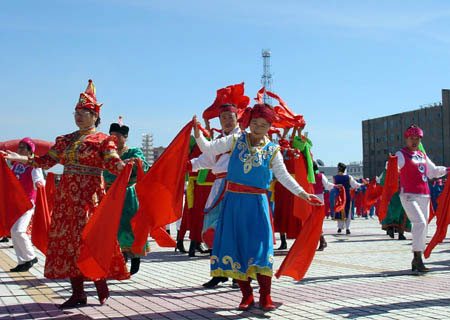Among the traditional Mongolian folk dances, Andai Dance is enjoyed and loved by people of all nationalities for its marked ethnic flavor and vigorous artistic features. About the origin of this dance there is a legend.
Long, long ago, on the Horqin grassland there lived a father and a daughter who were dependent on each other for survival. Suddenly stricken by an unknown disease, the daughter lost her mind and acted oddly. After several failures in attempting to cure her disease, the old fatherhad to take his daughter to other places by an ox cart toseek a cure. Unfortunately, mid way on the journey the axle of the cart broke when the daughter was almost dying from the worsening disease. The anxious father had no idea what to do but wander around the cart, singing a song to express his sorrow. The wailing song drew some people from the near vicinity, who couldn't help shedding tears at this sight and voluntarily followed the old father, swinging arms, stamping feet and crooning plaintively.To everyone's surprise, the daughter got off the cart quietly and followed the group, dancing. When the others found this, shewas dripping with perspiration and the disease was gone miraculously. Good news has wings. From then on, people began to follow suit and treat young women who suffered from similar diseases in such a way of singing and dancing, which was named "Andai". Later the dance was adopted in some mass rallies, such as "ceremonies to pray for rain", "the Obo sacrifices" and "Nadam Fairs (Nadam means game in Mongolian)". And the dance becameincreasingly popular until it was developed into a kind of group dance, which could freely depict life and express human emotion.
Traditionally, in the central space of the site of Andai Dance stands a cart wheel with its axle broken or a wooden pole (which is meantfor suppressing evils), circled by participants who will sing and dance after the leading singer and dancer, with silk scarvesin their hands or with the bottoms of their robes pulled up. The melody is tuneful, pleasing and good to express emotions. Thewords are rich in content, lively in language and have an impromptu quality. The major dancing movements include: stamping on theground while swinging silk scarves or slowly moving sideward; leaning forward while swinging silk scarves and kicking forward with small steps after straightening up; running in a circle while swinging silk scarves; jumping continuously while swingingscarves to two sides with effort.

